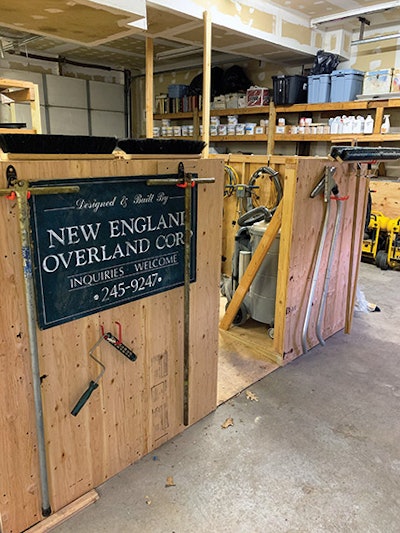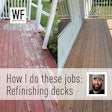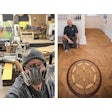


As a business owner, what's your reaction when one of your employees does something you don't like? What happens when he accidentally uses the wrong grit paper, or puts a tool in the wrong box so you can't find it later when you need it? If you're anything like me, you'd get a bit irritated and slightly curse their stupidity as you dig your only pair of Channellocks out of a box of sanding belts, or throw your arms in the air after you purchase three gallons of finish only to find five more buried under a pile of disorganized cords and sandpaper.
Three years ago, when I first reopened the doors to my family's hardwood floor business that had been dormant for over a decade, I had no clue what I was doing. In fact, I never planned to start a business in the first place. I was working for another gym floor company and doing side work on my own for extra cash whenever and wherever I could find it. We were just finishing up the busy summer season, and I was about to be out of work when a large flooring company called me and asked if I knew how to paint game lines. They had a 7,000-square-foot gym that needed installing, sanding and finishing.
I agreed to do the job, not having any idea how I was going to deliver a job that big in a timely fashion. All I had was myself, some old outdated saws and a couple of Clarke split-drum sanders my father purchased used in 1969. I wasn't even a real company yet. I made a couple of phone calls, then hired my little brother, an old timer who had worked for my father and another guy who had just been laid off from his job, and we went to work. They're all still with me today, and we'll never forget that first job, driving back and forth to Home Depot with four guys holding down pieces of Masonite to the roof of my Trailblazer so they wouldn't blow away.
RELATED: Getting My Business Out of My House (And My Mind)
Fast forward a few years, and the company was doing well. We had upgraded to a van, had bought a ride-on sander for gyms and had all new dustless equipment for residential jobs. I still had a big problem, however. As my business started gaining momentum, it became increasingly apparent how inefficient everything was. It was fine when we had only one job at a time: We'd forget a tool, and I'd have to drive an hour back to get it while the guys stayed on the job. But as the schedule tightened, I didn't have time for those mistakes. I had jobs to finish, jobs to start, appointments to keep. I needed everything to run like a well-oiled machine if I wanted to get my work done on time and keep my clientele happy … but it wasn't running that way at all.
My problem was disorganization. My shop was a disaster. Every once in awhile I'd tidy it up, but that never lasted long. After one or two jobs there would be crap piled everywhere, and I couldn't stay ahead of it. First I tried to put all the sanding equipment and materials on one side and the install equipment on the other. This worked to a degree, but essentially I ended up with two huge piles of crap instead of one. We had a general area of where things should go: pile the cords over here, big sanders and buffers in that corner, sandpaper over here … but it wasn't enough. My employees once sent me to pick up a roll of 80-grit sandpaper because we were out, only to discover a week later we had two rolls buried somewhere. Once I hit my breaking point, I realized I finally needed to do something. Yes, I could get angry at my employees, yell and carry on (and I did), but I finally realized it wasn't their fault, it was mine.
I decided to start implementing systems everywhere in my business, and it started with organizing the shop. Everything had to come up off the floor. We built a large platform in the middle with 5-foot walls all the way around that housed all our sanding equipment. Each machine has its own home and gets put in the exact same spot every time. To help us remember, we gave the machines names and labeled where they go. We have Barry Sander and Colonel Sander, Heath Edger and J. Edger Hoover, Jimmy Buffer, Austin Powerdrive, Winona Rider … you get the idea.
We also drilled in rafter hooks to hang the exceptional amount of cords and hoses we use, and they are organized by type. Each cord has a piece of different colored electrical tape around it that corresponds to its hook. There was no more "sandpaper goes on that shelf." One wall is now an area housing supplies. I decided which grits I needed to stock and lined them up from roughest to finest, starting with 12-inch rolls, then 8-inch rolls, then 8-inch belts. Another shelf has 5-, 6-, and 7-inch discs lined up the same way. Glue, rollers, T-bar sleeves, garbage bags, and anything else we buy regularly from our supplier has an exact spot; I can now walk in and see at a glance what needs to be reordered.
RELATED: How We Stopped Working Late Nights and Weekends
Once I finally saw my shop organized and staying that way, I decided to keep going. Each time I see something that bothers me, I try to find a way to conveniently and efficiently solve the problem. For instance, when I first bought new dustless equipment I liked to brag to potential clients how effective our machines were. One day when the guys were carrying a buffer I saw some dust fall from the inside of the machine and onto the floor. I thought it looked unprofessional, especially after boasting about how clean we were … time for some new protocol. We put a small compressor at the shop door, and now all machines get a quick once-over with the vacuum before going back into the van and are blown off outside of the shop with compressed air before returning to their homes in the shop, ensuring they'll be clean for next time.
Currently we're trying to put together a protocol for our sanding procedures. We started with sanding and coating gyms, and after finding a procedure that worked, we now repeat it every time with great success. The workers love it because they've become good at what they do and go home every day knowing they did a good job. I love it because once we have the procedure and the employees are trained to follow it, I don't have to be there anymore to make sure things are done correctly. I now have time to work elsewhere, fix different problems in my business, go to appointments to secure the next job, or just take a Wednesday afternoon off and go to the beach.
Putting your company's procedures on paper, implementing them and training employees on those procedures is one of the best things you can do for your company. Every large business and even governments are run this way. Once you have it on paper, you can always change it. There will always be unexpected problems on the job and someone will have to make the call on what to do, but having a set of rules and guidelines will make everyone's job that much easier and free up your time to work elsewhere.
































